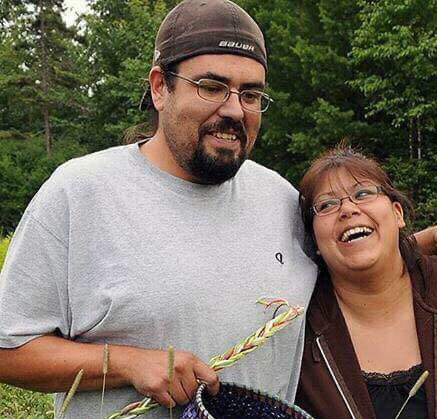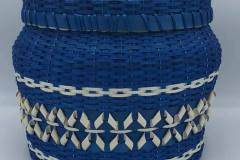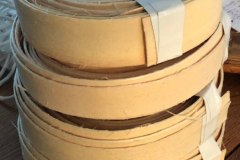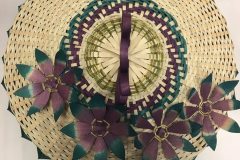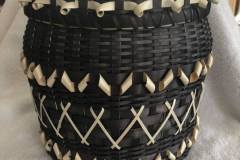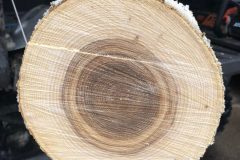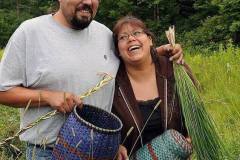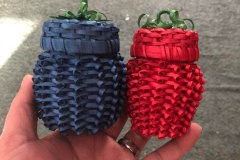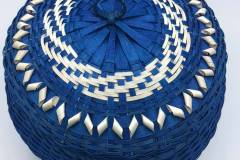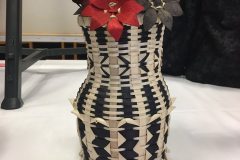The bounty of nature has no limits. Along with providing fish and game as nourishment for the body, nature also provides an assortment of flora for a variety of purposes. When we think of flora, we might think of flowers and plants, but trees are plants, too, only large ones. The black ash tree in the Upper Peninsula is giving Josh Homminga and Sarah Bedell of Brimley the opportunity to keep alive a tradition begun many years ago by Josh’s great-aunt, Bernadette Bouschor-Azevedo, a Native American.
As hunters and fishers pass along their knowledge to young members of their families, so too, Indigenous people want future generations to continue some of the old ways. In Josh’s case, it was the art of using a draw knife to scrap black ash bark, peel off layers, and make baskets. Through a casual conversation with Sarah, I became aware of the cottage business called “From Log to Basket” she and her husband run from their home on the Bay Mills Indian Reservation, an area rich in tradition and black ash trees.
“Josh wasn’t always interested in weaving baskets,” Sarah said. “He saw it as something his older relatives did as a means of income. It wasn’t until his Aunt Bernadette convinced him it was a way of connecting to his heritage that he decided to give it a try. After a few trips to the woods with his Uncle Roger, he knew the experience wasn’t just about weaving. It was about learning how to spot the perfect tree, scrap off the bark, peel layers off in long strips, and turn them into something useful and unrecognizable from the original tree.
“It’s not uncommon for our friends or relatives to contact Josh when they see the ‘perfect tree’—one approximately eight inches in diameter, straight as a match stick, and free of knots. Knots usually appear farther up the tree or in areas where branches used to be. One tree will usually yield two, 4-5’ sections. Once the tree is downed, the bark will either be scraped with a draw knife or peeled off by hand. It depends upon the time of year. In the late spring, whole sections of bark detach as easily as peeling a banana.
“The black ash is different from other trees,” Sarah explained. “Its growth rings are not connected by fibers. Spring is the best time to fell it because the outer layer of growth is weak and easier to crush when pounded. Each basket-maker has a preferred method of pounding. I use a wooden mallet, but Josh prefers using the back of an axe head. Both are effective in forcing ash layers to spring up. The summer layers are strong and tough and are peeled off in strips. Scraping the strips is a tiresome job. Each strip has a rough side that Josh has to scrape smooth with a sharp-edged knife.
“Obviously we have no control over the thickness of the layers, only how we use them. Thicker layers form the bottom of a basket. Thinner strips called ‘reeds’ are used as ribbons to weave the sides. Thick layers are scored and split into two thinner ones. It’s a tedious process and we spend a lot of time getting the strips ready for the next step. When this job is completed, the strips are rolled together according to size, fastened with a zip tie and kept in storage until needed. The rolling is necessary to prevent evaporation of the moisture.
“When we make baskets, sometimes we leave them in their natural state and other times we dye the strips. We find plain old Rit Dye works best. The longer the ribbons stay in the dye, the more vibrant the shades. Hues often vary due to the variations of darkness occurring in the strips. We offer a variety of colors, sizes, and shapes, but all our baskets have sweetgrass woven into the rim and lid of the basket. Sweetgrass is found locally and has been used by Native American tribes for centuries. Even when cut and dried, the grass retains its sweet aroma. It’s often referred to as ‘the grass that never dies.’
“Strawberry baskets are always popular, but we also make some baskets without lids. We make hanging baskets, large ones for storing yarn and the like, tiny ones where children can hide little treasures, and ones that have intricate decorative weaving on the outside. We’ve made vases and hats. The possibilities are only limited by our imaginations. If someone shows us a photo of what they want, we can usually replicate it and add our own special touches.
“Once Josh began the process from start to finish, the scent of fresh ash and the finished baskets brought memories of his childhood. That was when he realized this was something he wanted to teach his children. It takes patience and dedication to learn this traditional craft. A large basket takes 40 hours to weave, not including all the prep time. The black ash tree gives us the raw material to create something that will last a lifetime when given proper care. In olden days, baskets were used for practical purposes like carrying water from the lake, but now most people purchase them as decorative pieces.”
To learn more about their handcrafted baskets and other items and how to obtain them, visit their Facebook page at https://www.facebook.com/fromlogtobasket/ and check out the dates for their workshops.
Click image in gallery to enlarge
- Saying Goodbye to Charlie Brown - July 2, 2024
- Mike Lynn Says Farewell to Lynn Auto Parts, Inc. - November 25, 2022
- Sharon Kennedy:The Hay Fields of Tony Jarvie - August 11, 2022



